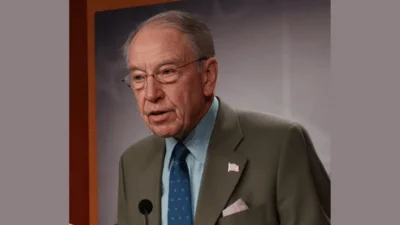The Congressional Record is a unique source of public documentation. It started in 1873, documenting nearly all the major and minor policies being discussed and debated.
“STATEMENTS ON INTRODUCED BILLS AND JOINT RESOLUTIONS” mentioning the U.S. Dept of State was published in the Senate section on pages S1848-S1850 on March 20, 2012.
The publication is reproduced in full below:
STATEMENTS ON INTRODUCED BILLS AND JOINT RESOLUTIONS
By Mrs. FEINSTEIN (for herself and Mr. Hatch):
S. 2212. A bill to clarify the exception to foreign sovereign immunity set forth in section 1605(a)(3) title 28, United States Code; to the Committee on the Judiciary.
Mrs. FEINSTEIN. Mr. President, I am very pleased to join with my colleague and good friend Senator Hatch to introduce this bill, which will resolve an unsettled issue that is making it difficult for museums and universities to obtain works of art for temporary exhibition from foreign countries.
Cultural exchange with foreign nations enables the sharing of ideas and history across the globe. When foreign works are shown at American museums, they expose our people to the richness of world history and culture.
In 2011, the San Diego Museum of Art hosted an exhibition of 64 works of famous Spanish artists, such as El Greco, Pablo Picasso, Francisco Goya, and Salvador Dali.
Also in 2011, the De Young Museum in San Francisco hosted an exhibition of more than 100 Picasso masterpieces from Paris, as well as more than 100 objects from the Olmec civilization in Mexico.
In 2009, the Los Angeles County Museum of Art hosted an exhibit containing artifacts from the Ancient Roman city of Pompeii, which was buried by a volcanic eruption and rediscovered in the 18th Century.
In 2007, the Los Angeles County Museum of Art hosted an exhibit with approximately 250 works of art created in more than seven different Latin American countries between 1492 and 1820.
Without these exhibitions coming to American museums, many Americans simply would not have the chance to see such important cultural and historical works in person. Exhibitions of such works also draw countless visitors each year, helping museums--which are vital to the preservation of our own culture and heritage--survive and thrive in difficult economic times.
For decades, American law has offered legal protection for these exhibitions. Passed in 1965, a law called the Immunity from Seizure Act, 22 U.S.C. 2459, is designed to provide the legal certainty necessary for American museums to organize such exhibitions with their foreign counterparts.
This law empowers the President or his designee to approve a foreign work for temporary exhibition or display in the United States, a process now handled by the State Department. If approval is granted, then the work of art is essentially protected from judicial process--
such as a court-ordered seizure--while it is in the United States.
Unfortunately, this important law has been undermined by a decision of the U.S District Court for the District of Columbia in a case called Malewicz v. City of Amsterdam.
In this case, the City of Amsterdam had made a temporary loan of works of art for educational and cultural purposes to the Guggenheim Museum in New York and the Menil Collection in Houston Texas.
Even though the State Department's approval was sought and received for the temporary loan, the court held that the City of Amsterdam's temporary loan nevertheless subjected the City to Federal court jurisdiction in a lawsuit over the work of art.
The reason was that--even though the loan was for educational and cultural purposes, for works to be shown at museums--the City's activities nevertheless qualified as ``commercial activity'' under a provision of the Foreign Sovereign Immunities Act, 28 U.S.C. 1605(a)(3).
The result of this decision, unsurprisingly, is that foreign museums have been more reluctant to lend their art works to our museums in the United States.
The Executive Branch during the Bush administration recognized this problem and tried to correct it. It urged the D.C. Circuit to reverse the decision, saying in an amicus brief that the District Court's ruling was wrong, that it ``substantially undermine[d] the purposes'' of the Immunity from Seizure Act, and that it would ``discourage foreign states and other lenders from providing their artwork for temporary exhibit in the United States.'' Unfortunately the appeal was dismissed before the D.C. Circuit had a chance to correct this problem. That is why this bill is necessary.
Several museums in my home state--including the San Francisco Museum of Modern Art, the Asian Art Museum in San Francisco, the Los Angeles County Museum of Art, the Cantor Center for Visual Arts at Stanford University, and the Santa Barbara Museum of Art--have asked me to help restore the legal certainty that existed prior to the Malewicz decision. I know that institutions in Senator Hatch's home State of Utah have sought his help in this regard as well.
I am very pleased to say that Senator Hatch and I have worked together--along with House Judiciary Committee Chairman Lamar Smith, Ranking Member John Conyers, and Representatives Steve Chabot and Steve Cohen--to draft a narrow bill that we hope can be enacted quickly this year.
This bill is simple. It relies on the State Department's approval process. If the State Department approves a loan of a foreign art work--essentially immunizing the work from judicial seizure under existing law--then the foreign state's activities associated with the work's exhibition cannot be used to assert jurisdiction over the foreign state under the Foreign Sovereign Immunities Act, 28 U.S.C. 1605(a)(3).
This narrow approach does only what is necessary to fix the problem created by the Malewicz decision--nothing more, nothing less.
It is important to note that this bill would not apply if the foreign state does not seek or receive the State Department's approval. The State Department requires detailed certifications and independent investigations about an art work's provenance before it grants approval. The bill also expressly would not apply to any work taken in Europe by the Nazis or their collaborators.
Once again, I thank Senator Hatch and my colleagues in the House for working with me on this important legislation, which has already passed the House of Representatives by voice vote. I urge my colleagues to join us in supporting this legislation.
Mr. President, I ask unanimous consent that the text of the bill be printed in the Record.
There being no objection, the text of the bill was ordered to be printed in the Record, as follows:
S. 2212
Be it enacted by the Senate and House of Representatives of the United States of America in Congress assembled,
SECTION 1. SHORT TITLE.
This Act may be cited as the ``Foreign Cultural Exchange Jurisdictional Immunity Clarification Act''.
SEC. 2. CLARIFICATION OF JURISDICTIONAL IMMUNITY OF FOREIGN
STATES.
(a) In General.--Section 1605 of title 28, United States Code, is amended by adding at the end the following:
``(h) Jurisdictional Immunity for Certain Art Exhibition Activities.--
``(1) In general.--If--
``(A) a work is imported into the United States from any foreign country pursuant to an agreement providing for the temporary exhibition or display of such work entered into between a foreign state that is the owner or custodian of such work and the United States or 1 or more cultural or educational institutions within the United States;
``(B) the President, or the President's designee, has determined, in accordance with Public Law 89 259 (79 Stat. 985; 22 U.S.C. 2459), that such work is of cultural significance and the temporary exhibition or display of such work is in the national interest; and
``(C) notice has been published in the Federal Register in accordance with Public Law 89 259,
any activity in the United States of such foreign state or any carrier associated with the temporary exhibit or display of such work shall not be considered to be commercial activity for purposes of subsection (a)(3).
``(2) Nazi-era claims.--Paragraph (1) shall not apply in any case in which--
``(A) the action is based upon a claim that the work was taken in Europe in violation of international law by a covered government during the covered period;
``(B) the court determines that the activity associated with the exhibition or display is commercial activity; and
``(C) a determination under subparagraph (B) is necessary for the court to exercise jurisdiction over the foreign state under subsection (a)(3).
``(3) Definitions.--For purposes of this subsection
``(A) the term `work' means a work of art or other object of cultural significance; and
``(B) the term `covered government' means--
``(i) the Nazi government of Germany;
``(ii) any government in any area occupied by the military forces of the Nazi government of Germany;
``(iii) any government established with the assistance or cooperation of the Nazi government; and
``(iv) any government that was an ally of the Nazi government of Germany; and
``(C) the term `covered period' means the period beginning on January 30, 1933, and ending on May 8, 1945.''.
(b) Applicability.--The amendment made by subsection (a) shall apply to cases commenced after the date of the enactment of this Act.
Mr. HATCH. Mr. President, I join the Senator from California, Senator Feinstein, in introducing legislation to clarify the legal protections for art that is loaned from overseas for exhibition in the United States. This bill passed the House yesterday by voice vote and I hope it can soon become law.
We are blessed in this country to have so many fine institutions that provide exposure to the art, culture, and history of other lands. Both public and private art museums can be found all over America, including at many of our fine universities. We must ensure that the exhibitions hosted by these museums continue to benefit all Americans.
A major exhibition can take years to develop and potential overseas lenders must be assured that their art will be legally protected while it is in the United States. Many exhibitions simply will not be possible without that assurance. We have had laws in place for decades that did just that, and they worked exactly the way they were supposed to. Specifically, the Protection from Seizure Act guaranteed that once the State Department reviewed and certified an exhibition as being in the national interest, the art was immune from legal judgments or court orders while in this country.
This legal protection was thrown into doubt by a Federal court decision several years ago. The U.S. District Court here in the Washington considered a case involving the Foreign Sovereign Immunities Act, which allows certain kinds of lawsuits against foreign countries in American courts. One of those categories is when art allegedly taken in violation of international law is present in this country in connection with a commercial activity. The court construed that condition of being present ``in connection with a commercial activity'' in a way that could include art that is here for exhibition under the Protection from Seizure Act.
The dilemma here is easy to see. These statutes are not supposed to be in conflict. Bringing art here under the protection of one statute is not supposed to create jurisdiction for a lawsuit against the lender under another statute.
The solution is also easy to see. The bill we introduce today is very short and very simple. It clarifies that the presence in this country of art under the Protection from Seizure Act does not create jurisdiction for a lawsuit under the Foreign Sovereign Immunities Act. It simply returns these two statutes to the harmony they were intended to have all along and to lift the cloud of doubt that has hung over the art exhibition process for the last several years.
I want to thank the Brigham Young University Museum of Art for bringing this issue to my attention. The BYU museum is the premier art museum in the Mountain West and the most attended university art museum in North America. BYU is the organizing institution for a major exhibition titled Beauty and Belief: Crossing Bridges with the Art of Islamic Cultures. This amazing event, which will be at BYU through September and is free to the public, includes art from a dozen foreign countries. As this project was in development, the museum director raised with me the need to clarify the law protecting art loaned for exhibition. Thankfully, the BYU exhibition was not hindered, but the Association of Art Museum Directors has documented that this is a problem elsewhere.
This is a problem that is easy to fix. It is not a partisan or an ideological issue. It is not a spending program. It involves neither regulations nor taxes. Each of our States has institutions that can benefit from this clarification. As my colleagues will see, we did put a caveat in the bill so that it will not apply to the ongoing efforts to identify and recover art and cultural objects seized by the Nazis during the World War II era.
Again, I want to applaud the BYU Museum of Art for its triumphant exhibition and for bringing this issue to my attention so that Americans can continue to enjoy this enriching and educational experience. I thank my colleague from California for introducing this bill, and for working to refine its language so that we can solve this specific problem. This short bill proves that good things can come in small packages and I hope the Senate will follow the House and quickly pass this bill.
____________________








